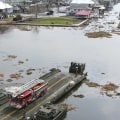The Louisiana Emergency Operations Center (SEOC) is a vital part of the state's emergency response system. It is responsible for coordinating and managing disaster planning, response, and mitigation of critical incidents. The SEOC can be activated in response to natural disasters, severe weather events, man-made disasters, terrorist threats, or other major emergencies. In this capacity, it serves as a central operations center to meet high-profile security needs and provide support to other state agencies and departments. Personal protective equipment (PPE) is essential for personnel safety during an emergency situation.
The senior emergency response officer who responds to an emergency will become the person in charge of the site-specific Incident Command System (ICS). All employees must receive an initial briefing on site before participating in any emergency response. Any employee who presents signs or symptoms that may have resulted from exposure to hazardous substances during the course of an emergency incident must receive a medical consultation.
Awareness-raising first responders
are people who are likely to witness or discover the release of a dangerous substance and have been trained to initiate an emergency response sequence by notifying the appropriate authorities. All employers must develop and implement an emergency response plan within the scope of paragraphs (a) (i) to (ii) of this section to manage anticipated emergencies before the start of hazardous waste operations.The Campus Emergency Operations Center uses emergency text messaging services to notify campus staff of an emergency affecting the university. The program will be designed to identify, evaluate, and control safety and health hazards in facilities in order to protect employees, provide an emergency response that meets the requirements of paragraph (p) () (of this section), and address site analysis, engineering controls, maximum exposure limits, hazardous waste management procedures, and the use of new technologies. The Unified Command Group (UCG) provides a unified and coordinated approach to the management of emergency incidents, allowing institutions, government authorities, and agencies with different legal, geographical, and functional responsibilities to coordinate, plan, and interact effectively. An employee alarm system must be installed in accordance with 29 CFR 1910.165 to notify employees of an emergency situation; stop work activities if necessary; reduce background noise to speed up communication; and initiate emergency procedures. Current status and capabilities of emergency response teams that would provide assistance to employees of the hazardous waste cleaning site at the time of an emergency must be assessed. Training should be based on the duties and role that each first responder in an emergency response organization will perform.
Logistical planning
before a disaster is essential for ensuring that the right systems are in place before a disaster or emergency occurs.This allows necessary resources (equipment, materials, supplies, and labor) to be identified and available in a timely and efficient manner when communities are affected by a disaster or emergency. Employers who are not required for employees to participate in emergency response, who order their employees to evacuate in case of such emergencies, and who comply with the requirements of paragraph (p) (i) of this section are exempt from the rest of paragraph (p) (of this section).






